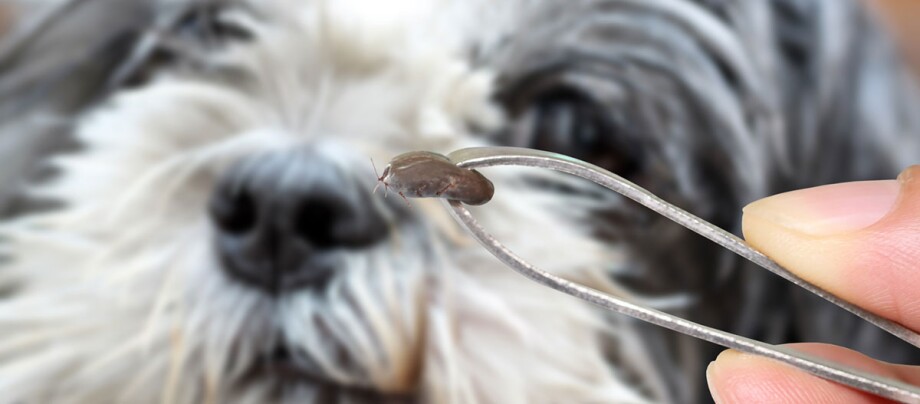Tick Bites on Dogs - How You Can Protect Your Pet
02.05.2025 - Reading time: 8 minutes

As the first flowers bloom and spring arrives, ticks spring back into action. It’s essential to ensure your dog is protected right from the start of the season. The common wood tick, alluvial forest tick, and brown dog tick lurk in tall grass and undergrowth, targeting dogs as their preferred hosts. A tick bite can transmit serious diseases to your dog, such as tick-borne encephalitis (TBE), Lyme disease, Babesiosis, Ehrlichiosis, or Anaplasmosis. Proper tick protection, vigilant observation, and emergency supplies will help you and your dog navigate tick season safely. Read our guide and keep your dog safe!
- Ticks and tick bites in dogs: How do ticks get on to your dog?
- What happens when a tick bites your dog?
- Ticks and diseases are on the increase: What do you need to be mindful of with tick bites?
- The brown dog tick and its pathogens
- The castor bean tick and its pathogens
- The meadow tick and its pathogens
- Important note
- What to do if your dog is bitten: tick tweezers and tick hooks
- Holidays with your dog - protection against ticks when abroad
- Information graphic
Ticks and Tick Bites in Dogs: How Do Ticks Get on Your Dog?
As soon as the temperatures start to rise, the dreaded tick season begins. Ticks don’t follow a calendar; they just need a comfortable temperature of around 7°C to become active. If you live in a consistently warm area or are on holiday, then “tick season” can last all year round!
Ticks (Ixodidae) are arachnids and belong to the subclass of mites that feed parasitically on the blood and lymphatic fluid of their hosts. You can recognize them by their triangular, flattened body with eight long legs and a small mouth area. They range in color from dark brown to red-brown. Some species have a shield (hard-bodied ticks), while others do not have an exoskeleton (Argasidae).
If you closely examine a tick, you can clearly see its mouth, which have parts that are shaped like pincers at the end of its head. The actual piercing tool is hidden between these “pincers” and is used for feeding while also holding onto the victim. Thus, the term “tick bites” actually refers to the tick piercing through the skin.

andrei310/stock.adobe.com
Ticks go through several stages before they become fully grown. They lay eggs outside the host (e.g., on the dog bed), which hatch into larvae. These larvae develop into nymphs, which eventually become adult ticks. Ticks are active parasites during all three stages, biting dogs, humans, and other animals to continue their development. The larvae and nymphs are small and hard to spot, but adult ticks can be seen relatively well with the naked eye, provided your dog’s coat allows for easy viewing. Once the tick is full of blood, it will be easy to see, with its grey, bulging body. Fully fed female ticks can reach up to 3 cm in size.
Ticks prefer to live in locations like the edges of woods and forests, meadows, clearings, and parks. They sit on high grass stalks, low-hanging branches, and in bushes, reaching out with their forelegs equipped with special sensory organs to detect passing victims. They are alerted by odors (sweat), vibrations, and changes in CO2 levels (breath), allowing them to drop onto potential victims. Some tick species are active “hunters” and search for victims themselves.

K_Thalhofer / iStock / Getty Images Plus via Getty Images
Dogs are especially affected by ticks because they love to explore tick-prone areas. However, humans and other animals like cats, hedgehogs, birds, mice, rats, and sheep are also prey for ticks. Generally, ticks are specialized in specific hosts, and they have developed sophisticated anesthetics tailored to the immune systems of their specific hosts.
Once a tick lands on a dog, it searches for a suitable spot to bite, preferring thin-skinned areas that are well-supplied with blood, like the head, lumbar region, ears, and stomach. The fear of these bloodsuckers is justified because tick bites in dogs and humans transmit more pathogens than any other type of parasite, except for mosquitoes. Globally, there are around 900 species of ticks. In Europe, there are three main tick species: the wood tick, the alluvial forest tick, and the brown dog tick.
What Happens When a Tick Bites Your Dog?
Once a tick finds a suitable spot on your dog’s body, it scratches the skin with its mouth and inserts its proboscis into the wound. This is how it sucks lymph, cell fluid, and blood. Hard ticks have a long proboscis with barbs, which they use to latch firmly onto their host. During this process, the tick releases a secretion containing various active substances:
The secretion has the following active substances:
- An anesthetic to keep the feeding process undetected
- An anti-inflammatory to block the host’s immune system
- An anticoagulant to prevent the wound from closing and to ensure blood flow
- Ticks with a small, long proboscis with barbs release an adhesive substance to stick to the dog’s body
Protecting Your Dog from Tick-Borne Diseases
Ticks can carry pathogens like bacteria, viruses, and parasites, using the tick as an intermediate host. These pathogens may be acquired during a previous feeding from an infected host. When feeding, ticks release undigested blood residues into the dog’s wound, transmitting these pathogens and potentially causing serious illnesses.
Feeding Habits of Ticks
- Adult Male Ticks: Require only a small blood meal for sustenance while waiting for a female.
- Adult Female Ticks: Can feed for several weeks, needing more blood to produce eggs.
The risk of infection begins approximately three hours after the tick starts feeding, as it disgorges undigested blood and pathogens into the host’s wound. The danger increases with each hour the tick remains attached, making prompt removal crucial.
Ticks and diseases are on the increase: What do you need to be mindful of with tick bites?
Pathogens Transferred by Tick Saliva
Ticks’ saliva can transmit serious illnesses to dogs. In central Europe, the most dangerous ticks are the wood tick, alluvial forest tick, and brown dog tick. The brown dog tick thrives in warm, dry conditions and prefers dogs.
The Brown Dog Tick and Its Pathogens
Previously native to the Mediterranean, the brown dog tick (Rhipicephalus sanguineus) is now found in Germany and Switzerland due to global warming and imported dogs. These ticks are reddish-brown, ranging from 1-3 mm, with engorged females reaching up to 1.2 cm.

The brown dog tick’s life cycle—from larva to nymph to adult—occurs on the dog’s body, with eggs laid in resting areas. These ticks can survive up to a year without a blood meal and roam through living spaces.
Look for the following symptoms of the acute phase (up to three weeks incubation time after tick bite):
- Fever and fever episodes
- Vomiting
- Fatigue
- Swelling of the lymph nodes
- Occasional muscle twitching
- Shortness of breath / heavy breathing
Diseases Transmitted by Brown Dog Ticks
- Canine Ehrlichiosis (Ehrlichia canis): Caused by Rickettsia-type bacteria, attacking white blood cells and impairing the immune system. Symptoms include fever, vomiting, fatigue, swollen lymph nodes, muscle twitching, and heavy breathing.
- Babesiosis (Babesia canis vogeli): Runs a mild course and is rare in Central Europe but common in the Mediterranean, France, North Africa, and South America.
- Anaplasmosis: Similar to ehrlichiosis, caused by Anaplasma bacteria, attacking granulocytes. Symptoms include exhaustion and worsen with cross-infections.
The castor bean tick and its pathogens
The common wood tick (Ixodes ricinus) is larger than the brown dog tick and transmits Lyme disease, early summer meningoencephalitis (TBE), and anaplasmosis. Lyme disease is the most common tick-borne disease in dogs in Europe.
Symptoms of Lyme Disease (Borreliosis)
- Recurring fever, loss of appetite, and exhaustion (early stage)
- Joint pain and inflammation
- Muscle pain
- Lameness of front and hind legs
- Heart problems
Tick-Borne Diseases in Dogs: Symptoms and Prevention
Symptoms of Tick-Borne Diseases
The main symptom of tick-borne diseases is a reddish rash around the bite site, which is often hard to spot due to your dog’s thick coat or dark skin pigmentation. In severe cases, neurological damage may occur, leading to chronic illness or even fatality. While a borreliosis vaccination exists, it only covers a few Borrelia strains and requires additional tick prophylaxis.
The Meadow Tick and Its Pathogens
The alluvial tick (Dermacentor reticulatus) is larger than the wood tick and can be identified by its whitish marbled spine with a reddish-orange edge. It transmits babesiosis pathogens, Babesia canis canis, which live in red blood cells and destroy them, causing anemia. Initially a Mediterranean disease, babesiosis has spread to Germany, the Netherlands, Poland, and Switzerland. Known as “dog malaria,” untreated babesiosis can be fatal.
Early Symptoms of Babesiosis
- High fever or bouts of fever
- General dullness and weakness
- Pale yellowish mucous membranes
- Red to green-brown urine
- Kidney failure
- Digestive and circulatory disorders
- Edema
- Central nervous system disorders
Important Note
This guide is not a substitute for veterinary advice. Always consult a vet if your pet is unwell and follow their guidance on medication.
What to do if your dog is bitten: tick tweezers, tick hooks and tick loops
Checking Your Dog for Ticks
Dogs naturally explore undergrowth, fields, and bushes, making it essential to check them for ticks after every walk, especially from March to October. Brush your dog thoroughly and rub them with a white, slightly damp cloth to spot brown to reddish-brown mites or ticks. If you find a tick, use a tick removal device immediately.
Maxi Zoo offers various tick removal tools, such as tick tweezers and hooks, which can efficiently and painlessly remove ticks from sensitive areas.
Holidays with Your Dog: Protection Against Ticks When Abroad
When traveling with your dog, protect them from local parasites and pathogens.
Symptoms After a Tick Bite
- Bouts of fever
- Vomiting
- Loss of appetite
- Exhaustion
- Weight loss
Warning Symptoms
- Yellow to bloody urine
- Movement disorders (ataxias) and lameness
- Aching legs
- Bleeding and edema
If you notice these symptoms, take your dog to a vet immediately.


